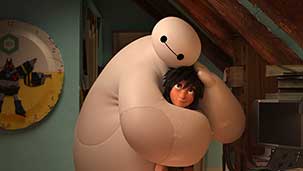The marketing materials for Big Hero 6 proudly exclaim “From the people who brought you Frozen, Tangled, and Wreck-it Ralph”, and that had me wondering if your job had gotten trickier in the last few years now that Disney seems to own, well, almost everything. You see, this could easily have been sold as “From the people who brought you Cars 2, and Toy Story.” Or even “From the people who brought you The Avengers, and Iron Man 3.” While it’s not marketed as either an official Pixar or Marvel film, Big Hero 6 is certainly as much a product of both of those entities as it is Disney alone.
More on that later.
Big Hero 6 introduces us to Hiro(!), a 14-year old loner who is a genius with robot design but is squandering his gift in the underworld of robot fighting - think Real Steel meets Bloodsport but with less, you know, blood. After Hiro’s older brother/father figure, Tadashi, tricks him into visiting the university robot lab where he studies, Hiro realizes he could do a whole lot more with his gifts. He’s also introduced to Tadashi’s motley assortment of classmates who have been conveniently pre-nicknamed by the class clown just in case they ever need secret identities.
Hiro’s mind is opened to new possibilities when he meets Baymax, Tadashi’s personal project. Baymax is a cuddly medical robot designed to treat all manner of illness and injury (in perhaps a nod to the lonely child relationship of E.T. The Extra Terrestrial, Baymax is activated when it hears someone say “Ouch”). Hiro sets his sights on impressing Tadashi’s professor, Dr. Callaghan, and landing a spot in the robot lab. Big Hero 6’s first act details Hiro’s transformation from punk kid to budding academic, culminating with Hiro’s creation of Micro-robots, small, intelligent, mind-controlled building blocks that can be used to construct anything their user can think of.
Of course, no hero’s journey is complete without the tragedy that sets him on the path to righteousness, and Big Hero 6 doesn’t break any new ground here. Anyone with a passing understanding of Joseph Campbell can guess at the fate of father figure-types. Suffice it to say, Hiro finds himself at a low point with Baymax as his only company. Also like E.T., Big Hero 6 gets a lot of second act mileage from Hiro trying to overcome Baymax’s rudimentary programming by teaching him how to behave more human. It also leads them to discover that Hiro’s Micro-robots, once thought lost to the aforementioned tragedy, are being used for some unclear nefarious purpose. Eventually the rest of the Robot Lab is brought in to help figure out what exactly is going on.
It’s at this point in the film that I started to think of the marketing quandaries you must have faced, Amy. You see, despite your and your team’s best efforts, I went into Big Hero 6 pretty ignorant of not only what it was about, but also of its origins. It wasn’t until Hiro and his friends spot the obligatory Stan Lee cameo, that I realized, this is also a Marvel movie!
You might not think that’s a huge deal, but it fundamentally changed my relationship to Big Hero 6. I could instantly see how the final two acts of the movie (Big Hero 6 is, atypically, broken into four acts) would play out; the heroes are assembled, each with a specific skill, they have one or two setbacks before coming together as a true unit and overcoming the villain.
It was a disappointment to realize that what I thought was a quirky and original film was slowly turning into the same formula I‘ve seen over and over. I’m not saying that you misled me—or even that the rest of Big Hero 6 is bad. In fact, it’s still highly enjoyable. The animation is great, as one would expect from a studio that is now overseen by Pixar’s braintrust,. The voice work by Scott Adsit, Ryan Potter, James Cromwell, and especially T.J. Miller, is top-drawer. And like The Incredibles and The Lego Movie, Big Hero 6 has some of the best action scene construction this side of Steven Spielberg. But once my expectations were set by that cameo, Big Hero 6 settled into little more than meeting them.
As I said in the opening to this letter, you could have just as easily marketed Big Hero 6 as a product created by any one of those corporate entities. It really feels like the result of that most 90s of terms, corporate synergy: the strategies and missions of each brand is met, but the result strips out whatever makes it unique. Watching Big Hero 6 is sort of like seeing that happen in real time.
Realizing how ignorance can be bliss,
Casey







